Remote Sensing-Based Monitoring of Agricultural Drought and Irrigation Adaptation Strategies in the Antalya Basin, Türkiye
Abstract
1. Introduction
2. Study Area
3. Material and Methods
3.1. Data
3.2. Drought Assessment Methodology
4. Results
4.1. Agricultural Drought Monitoring with Remote Sensing Indices
4.2. Correlation Analysis of Drought Indices
4.3. Adaptation Measures and Irrigation Efficiency Strategies
5. Discussion
6. Conclusions
Author Contributions
Funding
Data Availability Statement
Acknowledgments
Conflicts of Interest
Abbreviations
| ABA | Abscisic Acid |
| AOI | Area of Interest |
| CHIRPS | Climate Hazards Group InfraRed Precipitation with Stations |
| ERA5-Land | Fifth Generation ECMWF Atmospheric Reanalysis for Land |
| GEE | Google Earth Engine |
| LST | Land Surface Temperature |
| MODIS | Moderate Resolution Imaging Spectroradiometer |
| NDVI | Normalized Difference Vegetation Index |
| NDWI | Normalized Difference Water Index |
| NDDI | Normalized Difference Drought Index |
| PCI | Precipitation Condition Index |
| PRD | Partial Root-Zone Drying |
| SDCI | Scaled Drought Composite Index |
| SCADA | Supervisory Control and Data Acquisition Systems |
| SM | Soil Moisture |
| SMAP | Soil Moisture Active Passive |
| SMCI | Soil Moisture Condition Index |
| TCI | Temperature Condition Index |
| TDI | Traditional Deficit Irrigation |
| VCI | Vegetation Condition Index |
| VHI | Vegetation Health Index |
References
- Milly, P.; Dunne, K.; Vecchia, A. Global pattern of trends in streamflow and water availability in a changing climate. Nature 2005, 438, 347–350. [Google Scholar] [CrossRef]
- Mishra, A.K.; Özger, M.; Singh, V.P. Association between uncertainties in meteorological variables and water-resources planning for the state of Texas. J. Hydrol. Eng. 2010, 16, 984–999. [Google Scholar] [CrossRef]
- IPCC. Climate Change 2023: Synthesis Report. In Contribution of Working Groups I, II and III to the Sixth Assessment Report of the Intergovernmental Panel on Climate Change; Core Writing Team, Lee, H., Romero, J., Eds.; IPCC: Geneva, Switzerland, 2023. [Google Scholar] [CrossRef]
- Lesk, C.; Rowhani, P.; Ramankutty, N. Influence of extreme weather disasters on global crop production. Nature 2016, 529, 84–87. [Google Scholar] [CrossRef]
- Challinor, A.J.; Watson, J.; Lobell, D.B.; Howden, S.M.; Smith, D.R.; Chhetri, N. A meta-analysis of crop yield under climate change and adaptation. Nat. Clim. Change 2014, 4, 287–291. [Google Scholar] [CrossRef]
- Konapala, G.; Mishra, A.K.; Wada, Y.; Mann, M.E. Climate change will affect global water availability through compounding changes in seasonal precipitation and evaporation. Nat. Commun. 2020, 11, 3044. [Google Scholar] [CrossRef] [PubMed]
- Arslan, F.; Sawassi, A.; Derardja, B.; Değirmenci, H.; Lamaddalena, N. The effects of land consolidation projects on pressurized irrigation system design and the cost: A case study from Türkiye. Ecohydrol. Hydrobiol. 2024, 24, 608–616. [Google Scholar] [CrossRef]
- Han, X.; Wang, X.; Zhu, Y.; Huang, J.; Yang, L.; Chang, Z.; Fu, F. An experimental study on concrete and geomembrane lining effects on canal seepage in arid agricultural areas. Water 2020, 12, 2343. [Google Scholar] [CrossRef]
- Liu, Y.; Bai, M.; Zhang, K.; Zhang, B.; Li, Y.; Wang, Y.; Liu, J.; Liu, H.; He, Y. Study on the impact of pipe installation height on the hydraulic performance of combined canal–pipe water conveyance systems. Agriculture 2025, 15, 1347. [Google Scholar] [CrossRef]
- Bilgili, A.V. Spatial assessment of soil salinity in the Harran Plain using multiple kriging techniques. Environ. Monit. Assess. 2013, 185, 777–795. [Google Scholar] [CrossRef]
- Chukalla, A.D.; Krol, M.S.; Hoekstra, A.Y. Green and blue water footprint reduction in irrigated agriculture: Effect of irrigation techniques, irrigation strategies and mulching. Hydrol. Earth Syst. Sci. 2015, 19, 4877–4891. [Google Scholar] [CrossRef]
- Ibba, K.; Kassout, J.; Boselli, V.; Er-Raki, S.; Oulbi, S.; Mansouri, L.E.; Bouizgaren, A.; Sikaoui, L.; Hadria, R. Assessing the impact of deficit irrigation strategies on agronomic and productive parameters of Menara olive cultivar: Implications for operational water management. Front. Environ. Sci. 2023, 11, 1100552. [Google Scholar] [CrossRef]
- Fang, B.; Kansara, P.; Dandridge, C.; Lakshmi, V. Drought monitoring using high spatial resolution soil moisture data over Australia in 2015–2019. J. Hydrol. 2021, 594, 125960. [Google Scholar] [CrossRef]
- Tang, T.; Ge, J.; Shi, H.; Wang, L.; Cao, J.; Lee, X. Drought frequency, intensity, and exposure have increased due to historical land use and land cover changes. Commun. Earth Environ. 2025, 6, 398. [Google Scholar] [CrossRef]
- Spennmann, P.; Naumann, G.; Peretti, M.; Cammalleri, C.; Salvia, M.; Bocco, A.B.; Long, M.; Maas, M.; Kim, H.; Le, M.-H.; et al. Evaluation of a combined drought indicator against crop yield estimations and simulations over the Argentine Humid Pampas. Theor. Appl. Climatol. 2024, 156, 1473–1489. [Google Scholar] [CrossRef]
- Mahnamfar, F.; Nigussie, T.A. Assessment of drought characteristics and trend analysis in Antalya Basin, Turkey. J. Civ. Eng. Urban. 2023, 13, 18–24. [Google Scholar] [CrossRef]
- Zhao, C.; Liu, B.; Piao, S.; Wang, X.; Lobell, D.B.; Huang, Y.; Huang, M.; Yao, Y.; Bassu, S.; Ciais, P.; et al. Temperature increase reduces global yields of major crops in four independent estimates. Proc. Natl. Acad. Sci. USA 2017, 114, 9326–9331. [Google Scholar] [CrossRef]
- Candemir, S.; Ağızan, K.; Doğan, H.G.; Bayramoğlu, Z. Evaluating energy efficiency and carbon emissions in banana cultivation: The case of Antalya Province in Türkiye. Appl. Fruit Sci. 2025, 67, 99. [Google Scholar] [CrossRef]
- Serkendiz, H.; Tatlı, H.; Özcan, H.; Çetin, M.; Sungur, A. Multidimensional assessment of agricultural drought vulnerability based on socioeconomic and biophysical indicators. Int. J. Disaster Risk Reduct. 2023, 81, 104121. [Google Scholar] [CrossRef]
- Rhee, J.; Im, J.; Carbone, G.J. Monitoring agricultural drought for arid and humid regions using multi-sensor remote sensing data. Remote Sens. Environ. 2010, 114, 2875–2887. [Google Scholar] [CrossRef]
- Rebello, V.; Getirana, A.; Filho, O.; Lakshmi, V. Spatiotemporal vegetation response to extreme droughts in Eastern Brazil. Remote Sens. Appl. Soc. Environ. 2020, 18, 100294. [Google Scholar] [CrossRef]
- Lakshmi, V.; Le, M.-H.; Goffin, B.; Besnier, J.; Pham, H.; Do, H.; Fang, B.; Mohammed, I.; Bolten, J. Regional analysis of the 2015–16 drought monitoring over the Lower Mekong River Basin using NASA satellite observations. J. Hydrol. Reg. Stud. 2023, 46, 101362. [Google Scholar] [CrossRef]
- Lakshmi, V.; Kir, E.G.; Fang, B. Precipitation data accuracy and extreme rainfall detection for flood risk analysis in the Akçay Sub-Basin. Remote Sens. 2025, 17, 3199. [Google Scholar] [CrossRef]
- AghaKouchak, A.; Farahmand, A.; Melton, F.S.; Teixeira, J.; Anderson, M.C.; Wardlow, B.D.; Hain, C.R. Remote sensing of drought: Progress, challenges and opportunities. Rev. Geophys. 2015, 53, 452–480. [Google Scholar] [CrossRef]
- Pandey, V.; Srivastava, P.K.; Singh, A.K.; Suman, S.; Maurya, S. Techniques and tools for monitoring agriculture drought: A review. Arab. J. Geosci. 2024, 9, 497–519. [Google Scholar] [CrossRef]
- Besnier, J.; Getirana, A.; Beaudoing, H.; Lakshmi, V. Characterizing the 2019–2021 drought in the La Plata Basin with GLDAS and SMAP. J. Hydrol. Reg. Stud. 2024, 52, 101679. [Google Scholar] [CrossRef]
- Sur, K.; Lunagaria, M.M. Association between drought and agricultural productivity using remote sensing data: A case study of Gujarat State of India. J. Water Clim. Change 2020, 11, 189–202. [Google Scholar] [CrossRef]
- Chere, Z.; Debalke, D.B. Modeling agricultural drought based on the earth observation-derived standardized precipitation evapotranspiration index and vegetation health index in the northeastern highlands of Ethiopia. Nat. Hazards 2023, 120, 3127–3151. [Google Scholar] [CrossRef]
- Gu, Y.; Hunt, E.; Wardlow, B.; Basara, J.; Brown, J.; Verdin, J. Evaluation of MODIS NDVI and NDWI for vegetation drought monitoring using Oklahoma Mesonet soil moisture data. Geophys. Res. Lett. 2008, 35, L22401. [Google Scholar] [CrossRef]
- Kogan, F.N. Application of vegetation index and brightness temperature for drought detection. Adv. Space Res. 1995, 15, 91–100. [Google Scholar] [CrossRef]
- Farooq, M.; Wahid, A.; Kobayashi, N.; Fujita, D.; Basra, S.M.A. Plant drought stress: Effects, mechanisms and management. Agron. Sustain. Dev. 2009, 29, 185–212. [Google Scholar] [CrossRef]
- Park, S.; Seo, E.; Kang, D.; Im, J.; Lee, M.-I. Prediction of drought on pentad scale using remote sensing data and MJO index through random forest over East Asia. Remote Sens. 2018, 10, 1811. [Google Scholar] [CrossRef]
- Shahzad, M.U.; Tahir, S.; Rashid, J.; Khashan, O.A.; Ahmad, R.; Mansoor, S.; Ghani, A. Machine learning-based cotton yield forecasting under climate change for precision agriculture. Appl. Technol. 2025, 15, 101117. [Google Scholar] [CrossRef]
- Rosa, L.; Chiarelli, D.D.; Tu, C.; Rulli, M.C.; D’Odorico, P. Global unsustainable virtual water flows in agricultural trade. Environ. Res. Lett. 2019, 14, 114001. [Google Scholar] [CrossRef]
- OECD. Water Resources Allocation: Sharing Risks and Opportunities; OECD Publishing: Paris, France, 2015. [Google Scholar] [CrossRef]
- World Bank. Transforming Agriculture in Türkiye: Towards Climate-Smart Practices; World Bank Group: Washington, DC, USA, 2021; Available online: https://documents.worldbank.org/en/publication/documents-reports/documentdetail/099455306072212423/idu0ffbe9b5600d8604f9d0a430240d1a6b54bc1 (accessed on 9 July 2025).
- Hatfield, J.L.; Dold, C. Water-use efficiency: Advances and challenges in a changing climate. Front. Plant Sci. 2019, 10, 103. [Google Scholar] [CrossRef] [PubMed]
- Bozorg-Haddad, O.; Dehghan, P.; Zolghadr-Asli, B.; Singh, V.P.; Chu, X.; Loáiciga, H.A. System dynamics modeling of lake water management under climate change. Sci. Rep. 2022, 12, 5828. [Google Scholar] [CrossRef] [PubMed]
- Klisch, A.; Atzberger, C. Operational drought monitoring in Kenya using MODIS NDVI time series. Remote Sens. 2016, 8, 267. [Google Scholar] [CrossRef]
- Patil, P.P.; Jagtap, M.P.; Khatri, N.; Madan, H.; Vadduri, A.A.; Patodia, T. Exploration and advancement of NDDI leveraging NDVI and NDWI in Indian semi-arid regions: A remote sensing-based study. Case Stud. Chem. Environ. Eng. 2024, 9, 100573. [Google Scholar] [CrossRef]
- Zhang, Y.; Wang, G.; Li, L.; Huang, M. A monitoring method for agricultural soil moisture using wireless sensors and the Biswas model. Agriculture 2025, 15, 344. [Google Scholar] [CrossRef]
- European Environment Agency (EEA). CORINE Land Cover (CLC) 2018, Version 2020_20u1; Copernicus Land Monitoring Service: Copenhagen, Denmark, 2020. Available online: https://land.copernicus.eu/pan-european/corine-land-cover/clc2018 (accessed on 9 July 2025).
- Brumfield, R.G.; Ozkan, B. Gender analysis of labor and resources in greenhouse vegetable production in the Antalya Province of Turkey. HortScience 2016, 51, 1547–1554. [Google Scholar] [CrossRef]
- Funk, C.; Peterson, P.; Landsfeld, M.; Pedreros, D.; Verdin, J.; Shukla, S.; Husak, G.; Rowland, J.; Harrison, L.; Hoell, A.; et al. The Climate Hazards Infrared Precipitation with Stations (CHIRPS)—A New Environmental Record for Monitoring Extremes. Sci. Data 2015, 2, 150066. [Google Scholar] [CrossRef]
- Wan, Z.; Hook, S.; Hulley, G. MODIS/Terra Land Surface Temperature/Emissivity 8-Day L3 Global 1 km SIN Grid V061 [Data set]. NASA Land Processes Distributed Active Archive Center. NASA LP DAAC. 2021. Available online: https://www.earthdata.nasa.gov/data/catalog/lpcloud-mod11a2-061 (accessed on 8 August 2025).
- Vermote, E. MODIS/Terra Surface Reflectance 8-Day L3 Global 500 m SIN Grid V061 [Data set]. NASA Land Processes Distributed Active Archive Center. NASA LP DAAC. 2021. Available online: https://www.earthdata.nasa.gov/data/catalog/lpcloud-mod09a1-061 (accessed on 8 August 2025).
- Lakshmi, V.; Fang, B. SMAP-Derived 1-km Downscaled Surface Soil Moisture Product (NSIDC-0779, Version 1); NASA National Snow and Ice Data Center Distributed Active Archive Center: Boulder, CO, USA, 2023. [Google Scholar] [CrossRef]
- Muñoz-Sabater, J.; Dutra, E.; Agustí-Panareda, A.; Albergel, C.; Arduini, G.; Balsamo, G.; Vitart, F. ERA5-Land: A state-of-the-art global reanalysis dataset for land applications. Earth Syst. Sci. Data 2021, 13, 4349–4383. [Google Scholar] [CrossRef]
- Orieschnig, C.; Cavus, Y. Spatial characterization of drought through CHIRPS and a station-based dataset in the Eastern Mediterranean. Proc. IAHS 2024, 385, 79–84. [Google Scholar] [CrossRef]
- Ergene, E.M.; Bektaş Balçık, F.; Balık Şanlı, F. Trends analysis of agricultural drought in Central Anatolian Basin, Turkey. Int. Arch. Photogramm. Remote Sens. Spatial Inf. Sci. 2024, XLVIII-4/W9, 141–148. [Google Scholar] [CrossRef]
- Tran, A.P.; Tran, B.C.; Campbell, S.B.; Nguyen, N.A.; Tran, D.H.; Nguyen, T.T.; Nguyen, A.D.; Duong, H.S. Spatio-temporal characterization of drought variability in data-scarce regions using global precipitation data: A case study in Cauto River Basin, Cuba. Sci. Rep. 2024, 14, 11659. [Google Scholar] [CrossRef]
- Feng, S.; Wang, W.; Zhang, Y.; Wei, Z.; Dong, J.; Weihermüller, L.; Vereecken, H. Fusing ERA5-Land and SMAP L4 for an improved global soil moisture product. Earth Syst. Sci. Data 2025, preprint under review. [Google Scholar] [CrossRef]
- Ma, H.; Zeng, J.; Chen, N.; Zhang, X.; Cosh, M.H.; Wang, W. Satellite surface soil moisture from SMAP, SMOS, AMSR2 and ESA CCI: A comprehensive assessment using global ground-based observations. Remote Sens. Environ. 2019, 231, 111215. [Google Scholar] [CrossRef]
- Mazzariello, A.; Albano, R.; Lacava, T.; Manfreda, S.; Sole, A. Intercomparison of recent microwave satellite soil moisture products on European ecoregions. J. Hydrol. 2023, 626, 130311. [Google Scholar] [CrossRef]
- Shi, P.; Leung, L.R.; Lu, H.; Wang, B.; Yang, K.; Chen, H. Uncovering the interannual predictability of the 2003 European summer heatwave linked to the Tibetan Plateau. npj Clim. Atmos. Sci. 2024, 7, 242. [Google Scholar] [CrossRef]
- Hong, X.; Jia, S.; Zhu, W.; Song, Z. Evaluation of global seamless soil moisture products over China: A perspective of soil moisture sensitivity to precipitation. J. Hydrol. 2024, 641, 131789. [Google Scholar] [CrossRef]
- Yang, K.; Wang, C.; Bao, H. Contribution of soil moisture variability to summer precipitation in the Northern Hemisphere. J. Geophys. Res. Atmos. 2016, 121, 12108–12124. [Google Scholar] [CrossRef]
- Republic of Türkiye, Ministry of Agriculture and Forestry, General Directorate of Water Management (GDWM). Water Efficiency Strategy Document and Action Plan (2023–2033); Republic of Türkiye, Ministry of Agriculture and Forestry, General Directorate of Water Management: Ankara, Türkiye, 2023. Available online: https://suverimliligi.gov.tr/wp-content/uploads/2023/10/su-vermliligi-eylem-plani-en.pdf (accessed on 9 July 2025).
- Du, L.; Tian, Q.; Yu, T.; Meng, Q.; Janscso, T.; Udvardy, P.; Huang, Y. A comprehensive drought monitoring method integrating MODIS and TRMM data. Int. J. Appl. Earth Obs. Geoinf. 2013, 23, 245–253. [Google Scholar] [CrossRef]
- Huang, S.; Tang, L.; Hupy, J.P.; Wang, Y.; Shao, G. A commentary review on the use of normalized difference vegetation index (NDVI) in the era of popular remote sensing. J. For. Res. 2021, 32, 1–6. [Google Scholar] [CrossRef]
- Kim, K.; Scanlon, T.; Bakar, S.; Lakshmi, V. Decoupling of ecological and hydrological drought conditions in the Limpopo River Basin inferred from groundwater storage and NDVI anomalies. Hydrology 2023, 10, 170. [Google Scholar] [CrossRef]
- Miura, Y.; Shamsudduha, M.; Suppasri, A.; Sano, D. A global multi-sensor dataset of surface water indices from Landsat-8 and Sentinel-2 satellite measurements. Sci. Data 2025, 12, 1253. [Google Scholar] [CrossRef]
- Jiang, C.; Ma, C.; Duan, S.; Min, X.; Zhang, Y.; Li, D.; Zhang, X. Monitoring of agricultural drought based on multi-source remote sensing data in Heilongjiang Province, China. J. Integr. Agric. 2025, in press. [Google Scholar] [CrossRef]
- Das, A.C.; Shahriar, S.A.; Chowdhury, M.A.; Hossain, M.L.; Mahmud, S.; Tusar, M.K.; Ahmed, R.; Salam, M.A. Assessment of remote sensing-based indices for drought monitoring in the north-western region of Bangladesh. Heliyon 2023, 9, e13016. [Google Scholar] [CrossRef]
- Pavur, G.; Lakshmi, V. Observing recent floods and drought in the Lake Victoria Basin using Earth observations and hydrological anomalies. J. Hydrol. Reg. Stud. 2023, 46, 101347. [Google Scholar] [CrossRef]
- Cai, S.; Zuo, D.; Wang, H.; Xu, Z.; Wang, G.; Yang, H. Assessment of agricultural drought based on multi-source remote sensing data in a major grain producing area of Northwest China. Agric. Water Manag. 2023, 278, 108142. [Google Scholar] [CrossRef]
- Gago, J.; Douthe, C.; Coopman, R.E.; Gallego, P.P.; Ribas-Carbo, M.; Flexas, J.; Escalona, J.; Medrano, H. UAVs challenge to assess water stress for sustainable agriculture. Agric. Water Manag. 2015, 153, 9–19. [Google Scholar] [CrossRef]
- Satapathy, T.; Ramadas, M.; Dietrich, J. A novel agricultural drought monitoring framework using remote sensing products. In Proceedings of the EGU General Assembly 2021, Online Conference, 19–30 April 2021. EGU21-10228. [Google Scholar] [CrossRef]
- Gaznayee, H.A.A.; Zaki, S.H.; Al-Quraishi, A.M.F.; Aliehsan, P.H.; Hakzi, K.K.; Razvanchy, H.A.S.; Riksen, M.; Mahdi, K. Integrating Remote Sensing Techniques and Meteorological Data to Assess the Ideal Irrigation System Performance Scenarios for Improving Crop Productivity. Water 2023, 15, 1605. [Google Scholar] [CrossRef]
- Barreales, D.; Capitão, S.; Bento, A.A.; Casquero, P.A.; Ribeiro, A.C. Adapting Almond Production to Climate Change through Deficit Irrigation and Foliar Kaolin Application in a Mediterranean Climate. Atmosphere 2023, 14, 1593. [Google Scholar] [CrossRef]
- Stagno, F.; Consoli, S.; Licciardello, F.; Virga, G.; Barbagallo, S.; Motisi, A. Water Use Efficiency in a Deficit-Irrigated Orange Orchard. Horticulturae 2024, 10, 498. [Google Scholar] [CrossRef]
- Urlić, B.; Runjić, M.; Mandušić, M.; Žanić, K.; Vuletin Selak, G.; Matešković, A.; Dumičić, G. Partial Root-Zone Drying and Deficit Irrigation Effect on Growth, Yield, Water Use and Quality of Greenhouse Grown Grafted Tomato. Agronomy 2020, 10, 1297. [Google Scholar] [CrossRef]
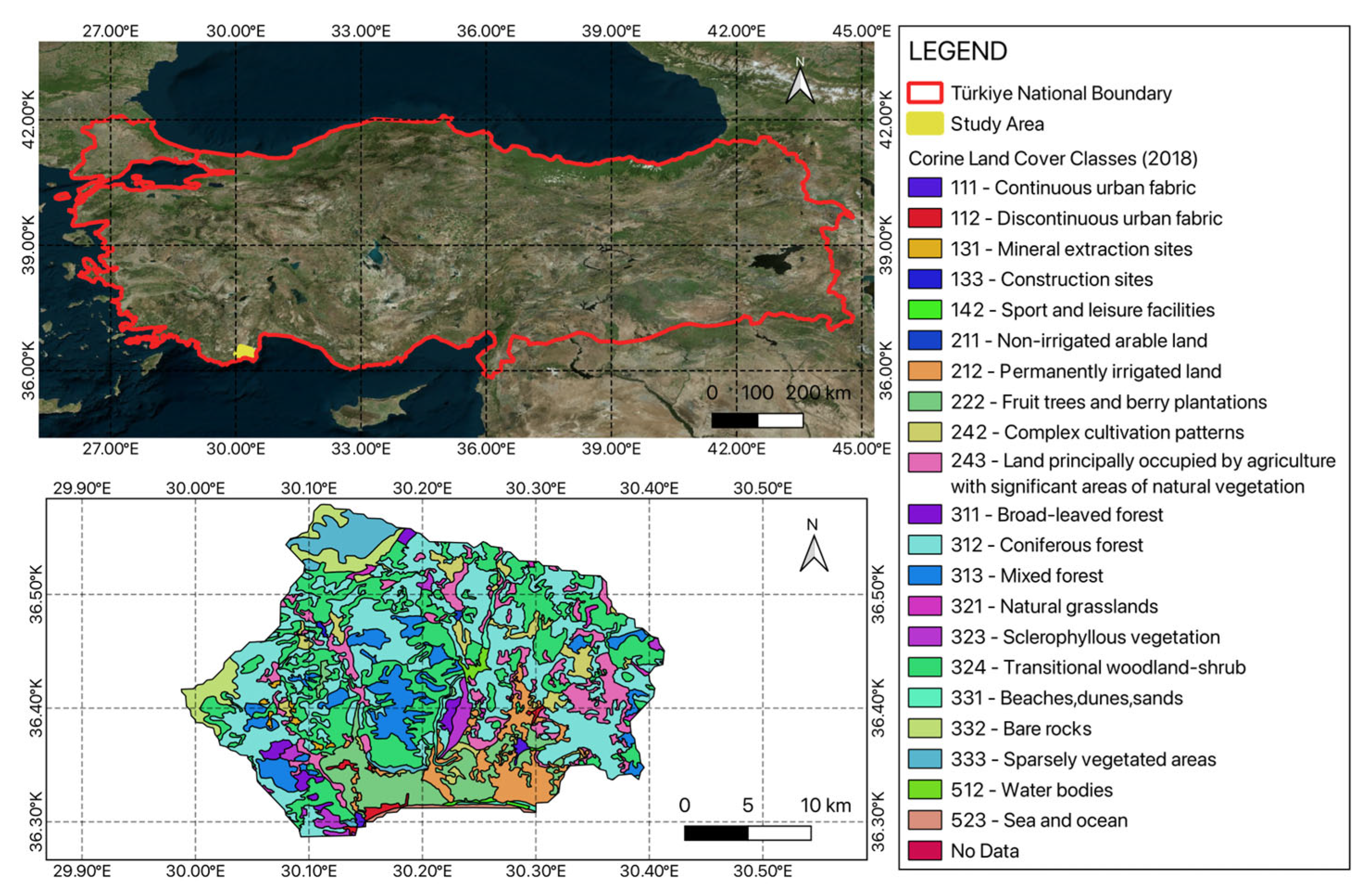
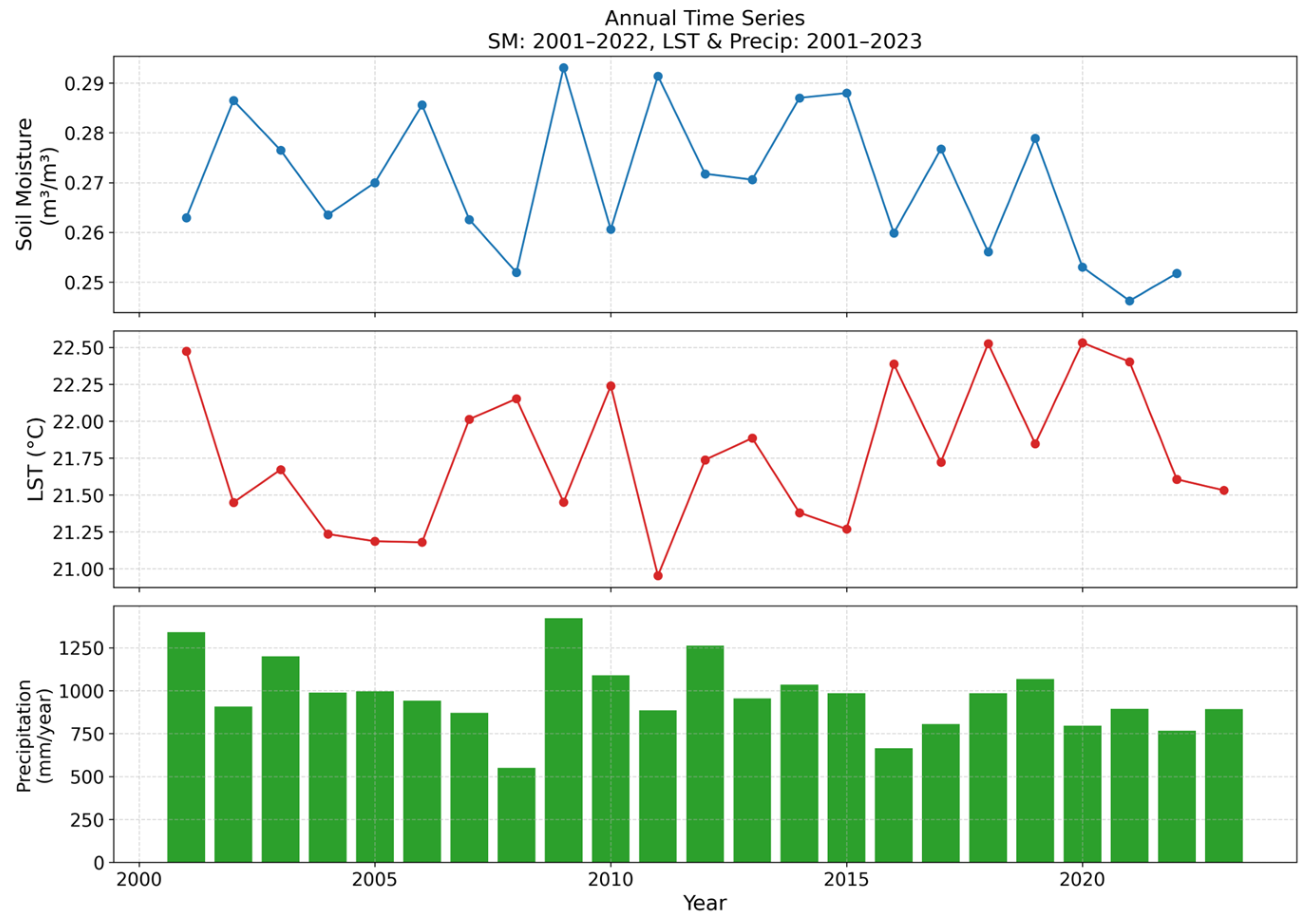

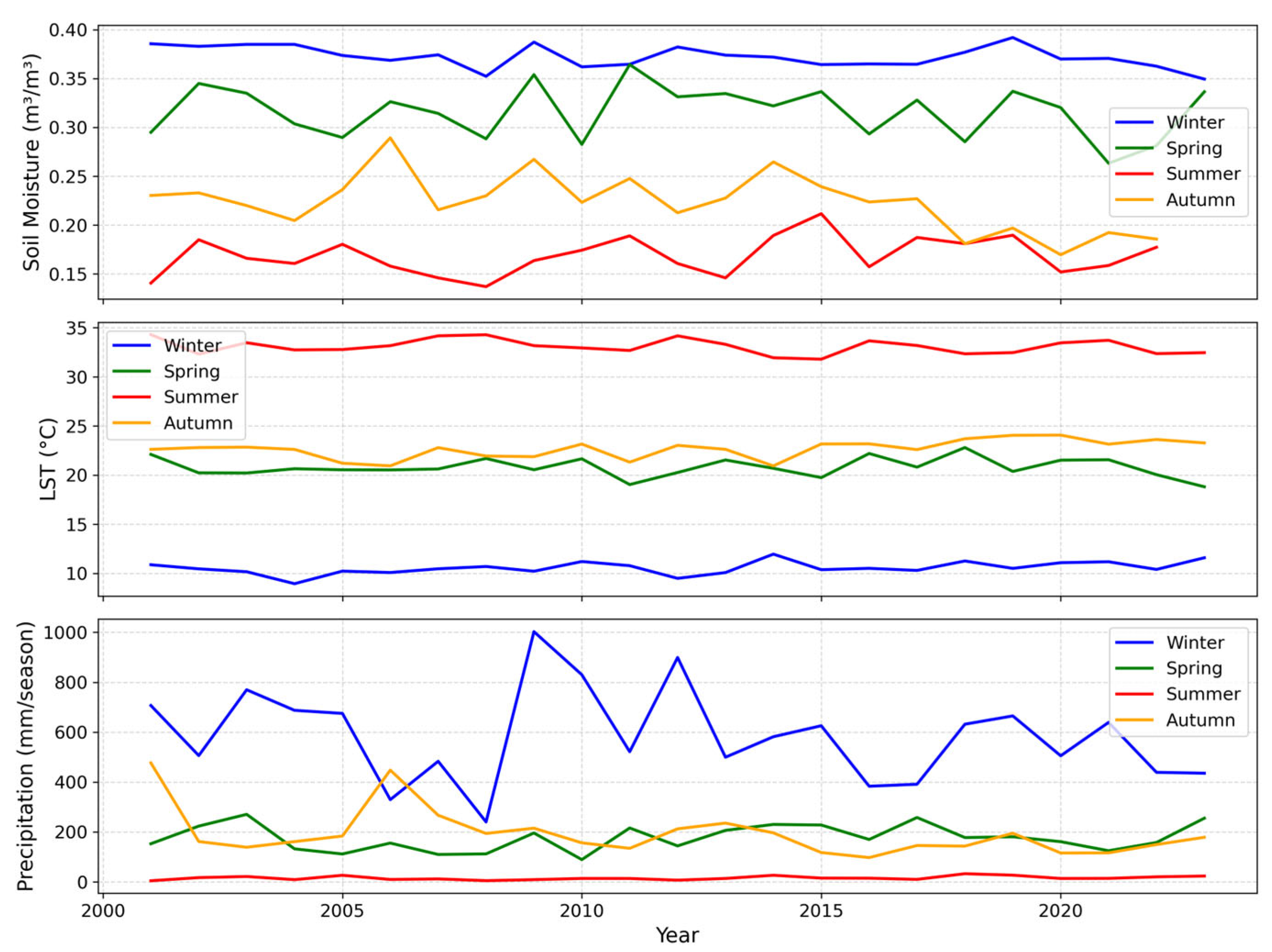

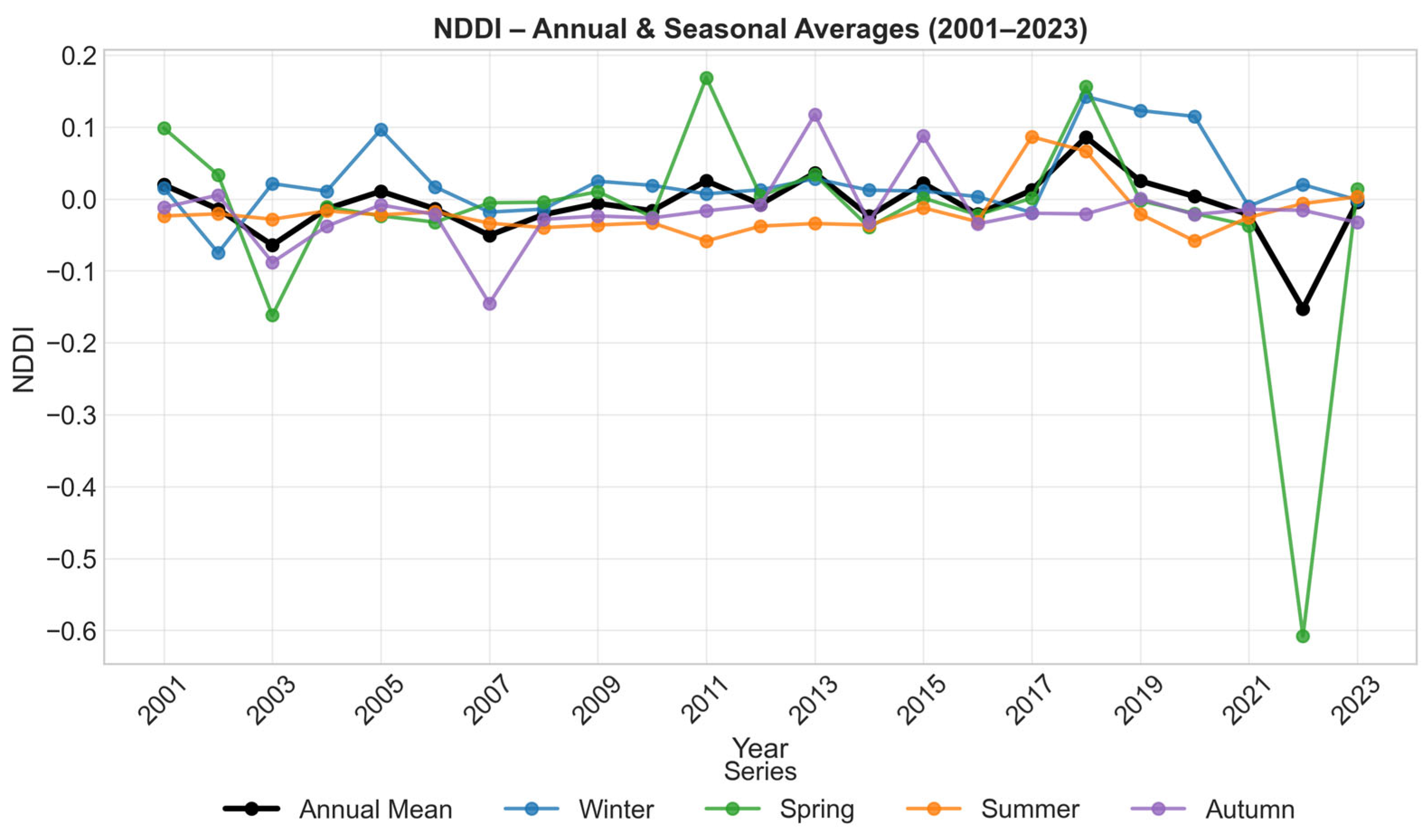

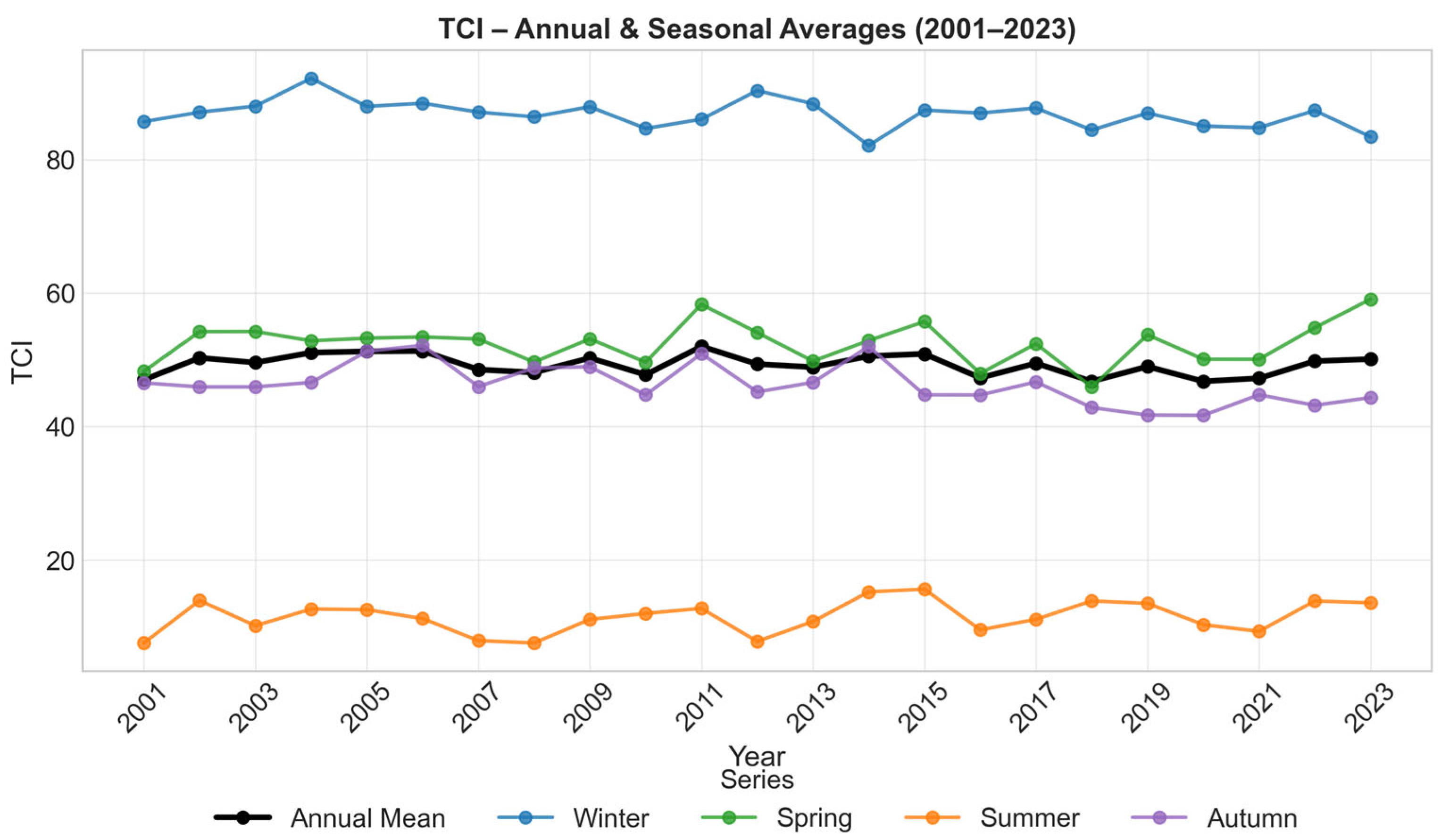

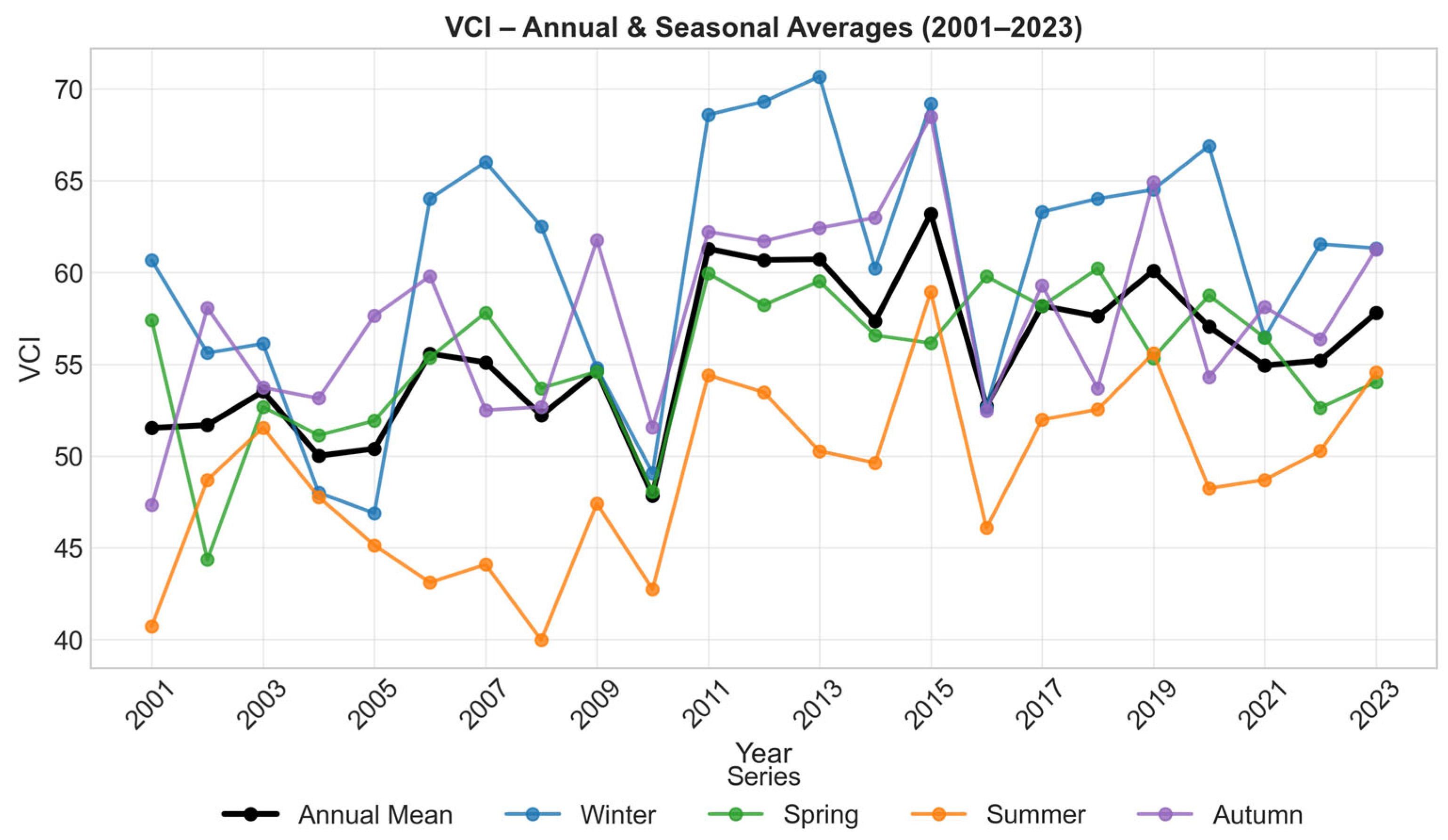

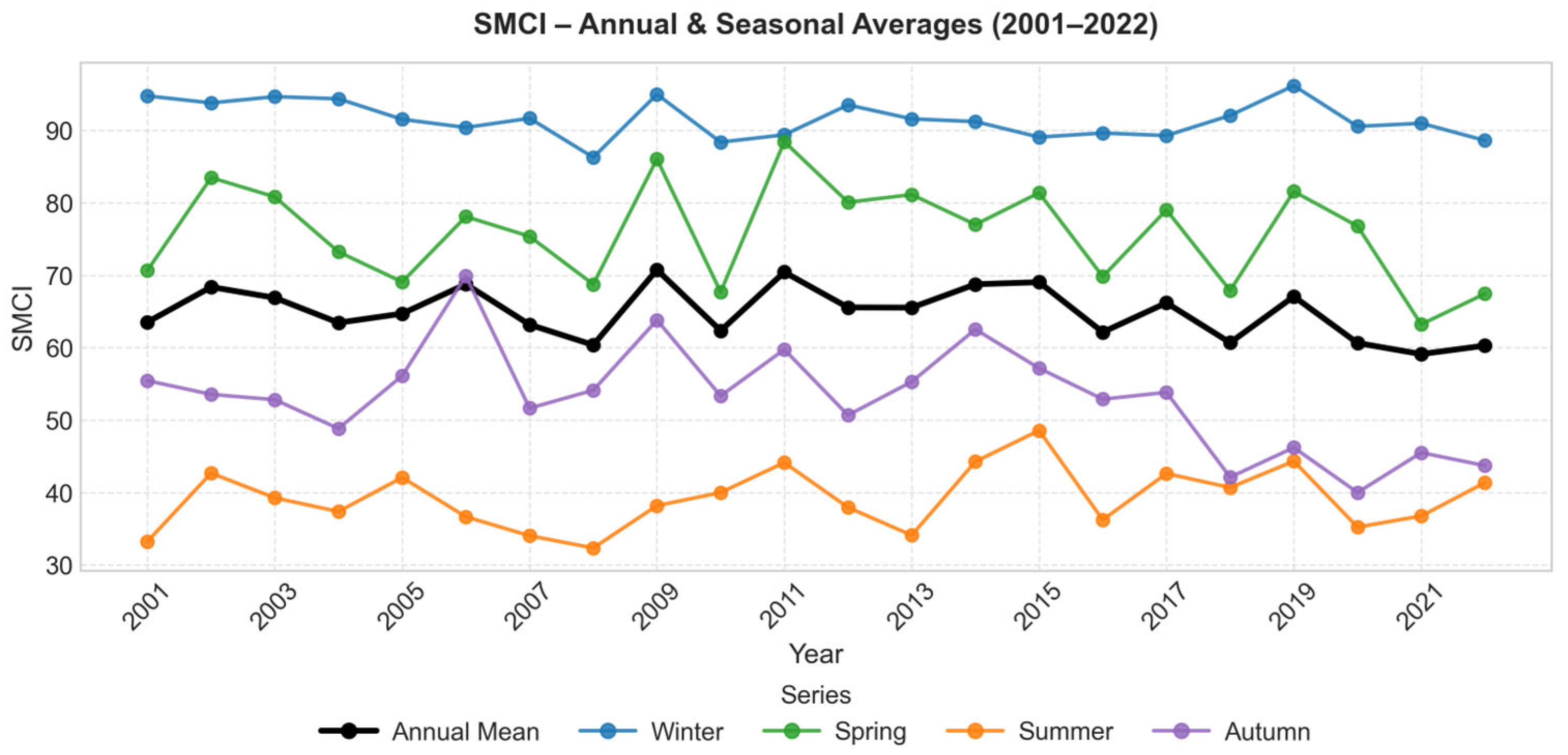

| DATA | Data Utility | Spatial Resolution | Temporal Resolution | Source |
|---|---|---|---|---|
| CHIRPS | Precipitation | 5 km | Daily/Monthly | CHIRPS [44] |
| MODIS MOD11A2.061 Terra Land Surface Temperature and Emissivity | LST | 1 km | 8-day/Monthly | MODIS [45] |
| MODIS MOD09A1.061 Terra Surface Reflectance | NDVI, NDWI | 500 m | 8-day/Monthly | MODIS [46] |
| SMAP 1 km | Soil Moisture | 1 km | Daily | NSIDC [47] |
| ERA5-Land | Soil Moisture | 9 km | Hourly/Monthly | ECMWF [48] |
| Remote Sensing Indices | Formula | Number |
|---|---|---|
| NDVI | (1) | |
| NDWI | (2) | |
| NDDI | (3) | |
| VCI | (4) | |
| TCI | (5) | |
| VHI | (6) | |
| PCI | (7) | |
| SDCI | (8) | |
| SMCI | (9) |
| Drought Class | NDDI Values |
|---|---|
| Non Drought | −1 < NDDI < 0.2 |
| Mild Drought | 0.2 ≤ NDDI < 0.3 |
| Moderate Drought | 0.3 ≤ NDDI < 0.4 |
| Severe Drought | 0.4 ≤ NDDI < 0.5 |
| Extreme Drought | 0.5 ≤ NDDI < 1 |
| Drought Category | SDCI, SMCI, TCI, VCI, VHI Values | PCI Values |
|---|---|---|
| Extreme Drought | 0 < SDCI, SMCI, TCI, VCI, VHI < 10 | 0 < PCI < 10 |
| Severe Drought | 10 ≤ SDCI, SMCI, TCI, VCI, VHI < 20 | 10 ≤ PCI < 20 |
| Moderate Drought | 20 ≤ SDCI, SMCI, TCI, VCI, VHI < 30 | 20 ≤ PCI < 30 |
| Mild Drought | 30 ≤ SDCI, SMCI, TCI, VCI, VHI < 40 | 30 ≤ PCI < 40 |
| Near Normal | 40 ≤ SDCI, SMCI, TCI, VCI, VHI < 60 | 40 ≤ PCI < 50 |
| Non Drought | 60 ≤ SDCI, SMCI, TCI, VCI, VHI < 100 | 50 ≤ PCI < 100 |
| NDDI | VCI | TCI | VHI | PCI | SDCI | SMCI | |
|---|---|---|---|---|---|---|---|
| Winter | 0.024 | 60.539 | 86.767 | 73.715 | 40.94 | 57.318 | 89.64 |
| Spring | −0.02 | 55.342 | 52.454 | 53.856 | 12.368 | 33.119 | 75.21 |
| Summer | −0.019 | 48.955 | 11.492 | 30.155 | 1.124 | 15.643 | 38.44 |
| Autumn | −0.017 | 57.674 | 46.354 | 52.006 | 13.467 | 32.741 | 54.33 |
| Annual | −0.008 | 55.628 | 49.267 | 52.433 | 16.975 | 34.705 | 64.28 |
| Index | Annual | Winter | Spring | Summer | Autumn |
|---|---|---|---|---|---|
| NDDI * non-drought conditional | Dry: 2018 Wet: 2022 | Dry: 2018 Wet: 2001 | Dry: 2011 Wet: 2022 | Dry: 2017 Wet: 2020, 2011 | Dry: 2013 Wet: 2007 |
| VCI * near normal | Dry: 2010 Wet: 2015 | Dry: 2005 Wet: 2013 | Dry: 2002 Wet: 2018, 2022 | Dry: 2008 Wet: 2015 | Dry: 2001 Wet: 2015 |
| TCI * near normal | Dry: 2018, 2020 Wet: 2011 | Dry: 2014, 2023 Wet: 2004, 2012 | Dry: 2018 Wet: 2011 | Dry: 2001, 2008 Wet: 2015 | Dry: 2020 Wet: 2014 |
| VHI * near normal | Dry: 2010 Wet: 2011, 2015 | Dry: 2005, 2010 Wet: 2012, 2013 | Dry: 2010 Wet: 2011 | Dry: 2001, 2008 Wet: 2015 | Dry: 2020 Wet: 2014, 2015 |
| PCI * severe and moderate drought | Dry: 2008, 2016 Wet: 2009, 2012 | Dry: 2008, 2016 Wet: 2009, 2012 | Dry: 2010 Wet: 2003 | Dry: 2008 Wet: 2018 | Dry: 2016 Wet: 2001 |
| SDCI * mild drought | Dry: 2008, 2016 Wet: 2009, 2012 | Dry: 2008, 2016 Wet: 2009, 2012 | Dry: 2010 Wet: 2003, 2011 | Dry: 2008 Wet: 2015, 2019 | Dry: 2016 Wet: 2006 |
| SMCI * non-drought | Dry: 2021 Wet: 2019 | Dry: 2008 Wet: 2009, 2019 | Dry: 2021 Wet: 2011 | Dry: 2008 Wet: 2015 | Dry: 2020 Wet: 2006 |
| Pair | Annual | Winter | Spring | Summer | Autumn |
|---|---|---|---|---|---|
| NDDI–PCI | 0.069 | −0.011 | −0.162 | −0.046 | 0.015 |
| NDDI–SDCI | 0.074 | −0.024 | −0.204 | −0.082 | 0.104 |
| NDDI–SMCI | 0.07 | 0.208 | −0.118 | −0.108 | 0.118 |
| NDDI–TCI | 0.053 | −0.013 | −0.251 | −0.143 | 0.126 |
| NDDI–VCI | 0.093 | −0.053 | 0.069 | −0.006 | 0.272 |
| NDDI–VHI | 0.069 | −0.053 | −0.201 | −0.085 | 0.184 |
| PCI–SDCI | 0.939 | 0.964 | 0.882 | 0.783 | 0.909 |
| PCI–SMCI | 0.705 | 0.414 | 0.689 | 0.823 | 0.696 |
| PCI–TCI | 0.756 | 0.378 | 0.685 | 0.684 | 0.636 |
| PCI–VCI | 0.371 | 0.003 | −0.045 | 0.500 | 0.420 |
| PCI–VHI | 0.728 | 0.174 | 0.605 | 0.667 | 0.592 |
| SDCI–SMCI | 0.851 | 0.383 | 0.847 | 0.891 | 0.872 |
| SDCI–TCI | 0.923 | 0.486 | 0.905 | 0.899 | 0.888 |
| SDCI–VCI | 0.57 | 0.244 | 0.225 | 0.853 | 0.721 |
| SDCI–VHI | 0.919 | 0.429 | 0.909 | 0.986 | 0.874 |
| SMCI–TCI | 0.916 | 0.522 | 0.851 | 0.832 | 0.874 |
| SMCI–VCI | 0.48 | −0.255 | 0.124 | 0.666 | 0.75 |
| SMCI–VHI | 0.889 | 0.015 | 0.821 | 0.845 | 0.875 |
| TCI–VCI | 0.537 | 0.079 | 0.033 | 0.581 | 0.788 |
| TCI–VHI | 0.974 | 0.515 | 0.922 | 0.892 | 0.975 |
| VCI–VHI | 0.713 | 0.895 | 0.419 | 0.886 | 0.904 |
| Measure Title | Description and Purpose | Expected Benefit |
|---|---|---|
| Traditional Deficit Irrigation (TDI) | Applies less water than full evapotranspiration, targeting stages less sensitive to water stress. | Expands irrigable area under limited water availability; maintains acceptable yields. |
| Partial Root Zone Drying (PRD) | Alternates irrigation sides of the root zone, triggering Abscisic Acid (ABA) signals to reduce transpiration. | Enhances water-use efficiency while maintaining plant health and yield. |
| Irrigation Infrastructure Rehabilitation | Replaces open-channel systems with pressurized closed-pipe networks. | Reduces losses from evaporation and seepage; improves delivery control. |
| Parcel Transmission Lines and Field Valves | Installs pipelines and control valves at the farm level to deliver and measure irrigation water. | Enables precise water delivery and individual consumption monitoring. |
| Supervisory Control and Data Acquisition systems (SCADA)-Based Automation and Telecontrol | Introduces centralized and field-level control of pumps, valves, flow, and pressure through remote sensing and data logging. | Optimizes water distribution and reduces unauthorized use or system inefficiencies. |
| Meteorological Station Integration | Deploys on-site weather stations to collect local climate data for irrigation planning. | Supports climate-based, demand-driven irrigation scheduling. |
| Water Measurement and Metering | Implements flow meters at field, intake, and mainline points to measure consumption accurately. | Enables transparent pricing and identifies leakages or unaccounted use. |
Disclaimer/Publisher’s Note: The statements, opinions and data contained in all publications are solely those of the individual author(s) and contributor(s) and not of MDPI and/or the editor(s). MDPI and/or the editor(s) disclaim responsibility for any injury to people or property resulting from any ideas, methods, instructions or products referred to in the content. |
© 2025 by the authors. Licensee MDPI, Basel, Switzerland. This article is an open access article distributed under the terms and conditions of the Creative Commons Attribution (CC BY) license (https://creativecommons.org/licenses/by/4.0/).
Share and Cite
Lakshmi, V.; Kir, E.G.; Kir, A.; Fang, B. Remote Sensing-Based Monitoring of Agricultural Drought and Irrigation Adaptation Strategies in the Antalya Basin, Türkiye. Hydrology 2025, 12, 288. https://doi.org/10.3390/hydrology12110288
Lakshmi V, Kir EG, Kir A, Fang B. Remote Sensing-Based Monitoring of Agricultural Drought and Irrigation Adaptation Strategies in the Antalya Basin, Türkiye. Hydrology. 2025; 12(11):288. https://doi.org/10.3390/hydrology12110288
Chicago/Turabian StyleLakshmi, Venkataraman, Elif Gulen Kir, Alperen Kir, and Bin Fang. 2025. "Remote Sensing-Based Monitoring of Agricultural Drought and Irrigation Adaptation Strategies in the Antalya Basin, Türkiye" Hydrology 12, no. 11: 288. https://doi.org/10.3390/hydrology12110288
APA StyleLakshmi, V., Kir, E. G., Kir, A., & Fang, B. (2025). Remote Sensing-Based Monitoring of Agricultural Drought and Irrigation Adaptation Strategies in the Antalya Basin, Türkiye. Hydrology, 12(11), 288. https://doi.org/10.3390/hydrology12110288







